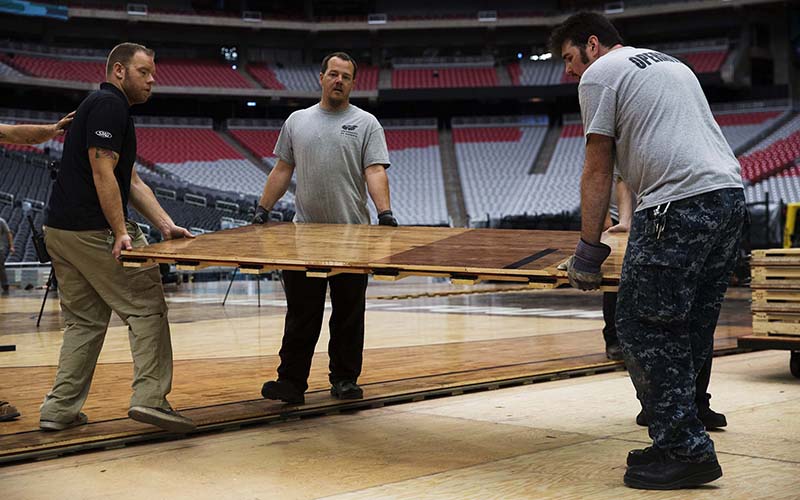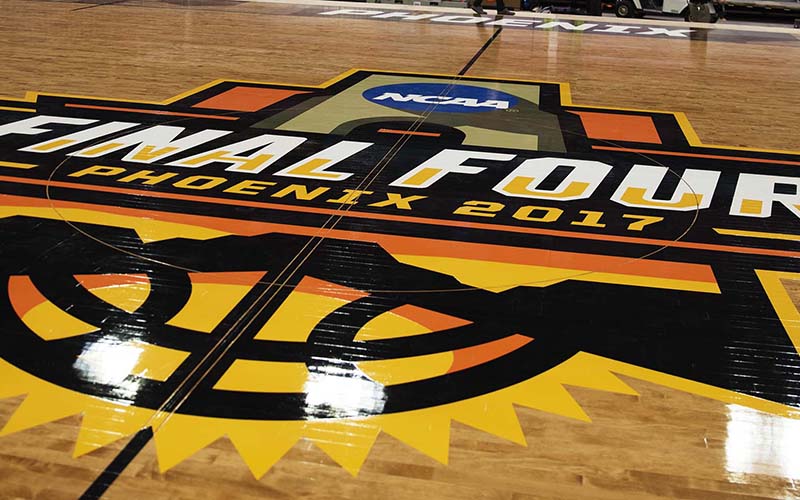
Local workers carry a piece of the Final Four court on March 24, 2017, in Glendale. (Photo by Blake Benard/Cronkite News)
GLENDALE — It’s been built. Now, it’s time to see who will come to play on it.
The NCAA Final Four court was installed at University of Phoenix Stadium on Friday, literally setting the stage for one of the premier events in sport.
Friday’s court installation was one of the final steps of a two-week setup process that included hanging a scoreboard above the court. The venue designed primarily for football will become the first facility in the western U.S. to host the NCAA Tournament’s national semifinal and championship games since 1995 when Seattle’s Kingdome, later demolished, played host to the Final Four.
University of Phoenix Stadium has played host to notable events before, including the Super Bowl and the College Football Playoff National Championship in the past two years, respectively. But nothing quite like this.
The games will be the first basketball contests played at the venue since the NCAA regional finals in 2009.
“These guys are clearly excited and enjoying being part of this, and it’s showing in how quickly they’re getting it done,” said Andrew Campbell, the director of partnerships and events for Gerflor, the company in charge of setting up the venue for the tournament.
“It never gets old for us.”
The floor installation process, which is just one small part of a combined effort to prepare University of Phoenix Stadium for the Final Four, takes only five hours to complete. With much of the preparation for both the stadium and for the fan events at the Phoenix Convention Center ahead of schedule, the crew was able to have 10 local workers team with the two lead technicians to put everything together.

The Final Four logo specialized for Phoenix sits at midcourt on March 24, 2017, in Glendale. (Photo by Blake Benard/Cronkite News)
Campbell is one of the two technicians who are now working on their combined 20th Final Four.
“This has been so far one of the best experiences we’ve had for these installations,” Campbell said. “Everyone here at this building from an operations standpoint has been, ‘What can we do for you?’ or ‘How can I help you?’ We were going too fast, which almost never happens.”
The court, made from sugar maple trees from the Nature Conservancy’s sustainably managed 24,000-acre Two Hearted River Forest Reserve in Michigan’s Upper Peninsula, will be 140 feet long by 70 feet wide when fully installed — about 20 feet longer and 10 feet wider than the typical NBA floor. This, Campbell said, will give room for the 3 foot raised stage and allow more room for fans to be on the court while still ensuring safety.
“The setup is crazy,” Campbell said. “It’s just a really unique atmosphere for basketball. I think when people come in here, you can see the faces of the athletes and people coming in here. It’s a really cool experience.”
Connor Sports is in charge of constructing the court from its start in September through this week’s installation and next week’s takedown. The Final Four court at University of Phoenix Stadium is one of 21 courts that will be used for games from the First Four in Dayton, Ohio, to the Final Four courts of both the men’s and women’s NCAA Tournaments.
Connor Sports marketing and communications specialist Brooke Cramblitt said the journey the court takes from start to finish is a long one.

The tools of the trade. A hammer and a metal block workers use to make sure all the individual pieces are tight and hammered home Final Four on March 24, 2017, in Glendale. (Photo by Blake Benard/Cronkite News)
Things first came together in September, when the NCAA submitted its design for the court. In November, the maple trees were cut down and milled in Amasa, a city of just 250 people in Michigan’s Upper Peninsula. From there, it went to Idaho Falls, Idaho where the wood was painted during a three-week process. Once the wood cured for a week, the blocks that measure 4 feet by 7 feet were ready to be shipped to the venue and assembled.
“It’s traveled from Michigan to Idaho to Arizona,” Cramblitt said. “It’s incredible. The people that are spending their time making sure this event goes off without a hitch, it’s really amazing. We get to see it all come together for people who are going to be watching these games from across the nation.”
Once a champion is crowned on April 3, the work on the court will once again commence. Around 2 a.m. the morning after the final game, Cramblitt said, crews will begin tearing down the court.
With Friday’s court installation, the only real remaining hurdle to having a full setup is the installation of the basket stanchions, backboards and hoops, which Campbell said Spalding will have installed by this weekend. From then on, everything will be ready to play — it’s just a matter of seeing which teams get there.
No matter who it is hoisting the national championship trophy on April 3, one thing is for sure — Campbell isn’t anticipating another long wait for the Final Four to return to the West.
“I’d love to come back here,” he said. “With an experience like this, I’d love to come back. It’s a spread-out Final Four between Glendale and downtown (Phoenix), but if it goes like this, I’d come back here in a heartbeat.”